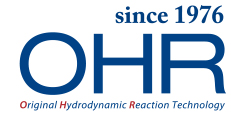Comparing OHR and porous air diffusers
Mechanism
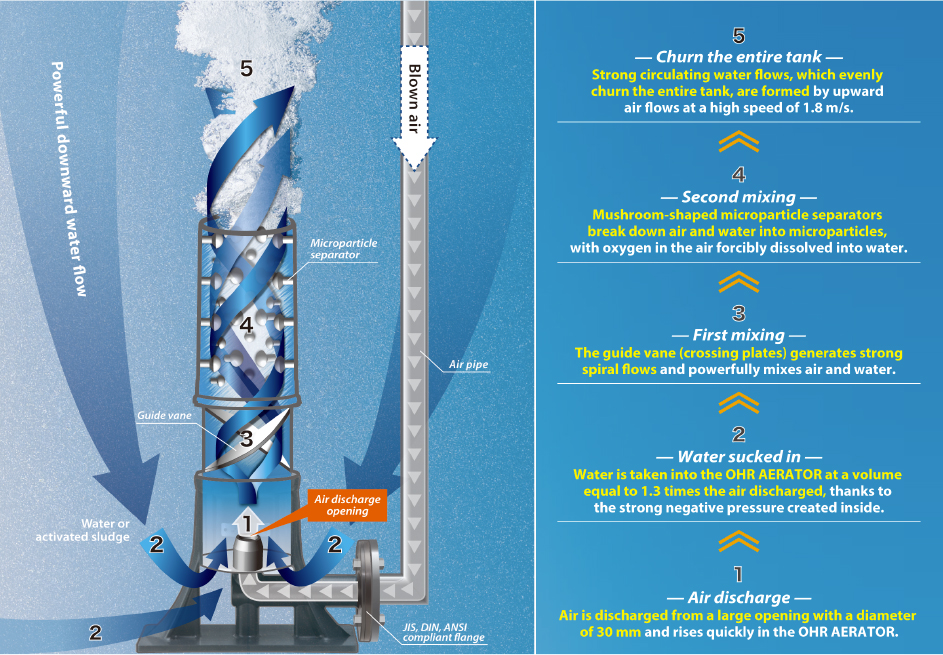
Why the OHR AERATOR never clogs and porous air diffusers always clog
Rubber porous air diffuser manufacturers claim that “clogging never occurs because rubber works as a check valve to prevent counterflow of activated sludge”. In that case, why is continual washing and replacement necessary in wastewater facilities all over the world?
Conventional air diffuser clogging: reason 1
In summer, the temperature of air sent to the diffuser exceeds 80°C
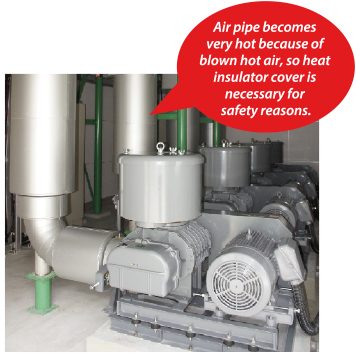
Air blowers work by taking in air, compressing it and discharging it. Because of this, the heat of compression is added to the temperature of the air at time of suction and it will discharge hot. The temperature of discharged air can be approximated using the following formula.

As an example, when the discharged air pressure is 55kPa* and the air temperature at time of suction is 30°C, air will discharge hot, at a temperature of 55 + 30 = 85 °C.
Evidently this will cause any activated sludge inside the air diffuser to dry and accumulate.
*55kPa comes from a water depth of 5.0 m + rubber porous air diffuser’ s air discharge resistance 0.5 m
Conventional air diffuser clogging: reason 2
Activated sludge counterflows into air diffusers when discharging air
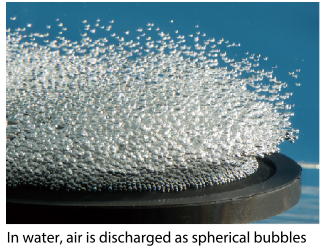 Air discharged into water actually discharges intermittently because of resistance (i.e. water pressure). This is why individual spherical bubbles of air are produced. (See photo at right)
Air discharged into water actually discharges intermittently because of resistance (i.e. water pressure). This is why individual spherical bubbles of air are produced. (See photo at right)
Water pressure causes activated sludge to counterflow into air diffusers in the intervals between individual discharges of air. The claim that "Air discharges from air diffusers continuously, so activated sludge does not counterflow" runs counter to the laws of physics.
Despite having just one large air discharge opening, the same applies to the OHR AERATOR: activated sludge counterflows into the opening at the same time that air discharges.
Conventional air diffuser clogging: reason 3
A 30 cm disc air diffuser installed 5.0 m down sits under 350 kg of water
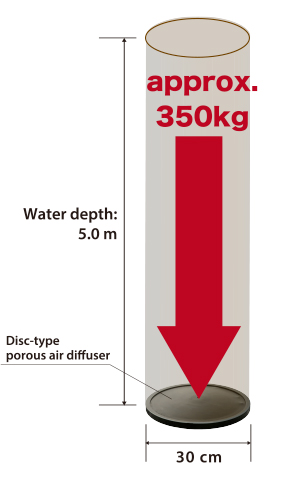
If a disc-type porous air diffuser with a diameter of 30 cm is installed on the floor of an aeration tank, at a water depth of 5.0 m, as much as 350 kg of water presses down on the air diffuser from above.
This means that a very strong force is continuously trying to counterflow the activated sludge into the air diffuser. The contraction of the rubber cannot stop this from happening.
There is no rubber in the world that can contract enough to stop the instantaneous counterflow that occurs in each of the many fine pores. On top of this, rubber gradually hardens over time, and air discharge openings no longer close, resulting in further activated sludge counterflow. As shown in the picture below, this applies even to silicon rubber porous air diffusers, which are commonly regarded as exceptionally durable.
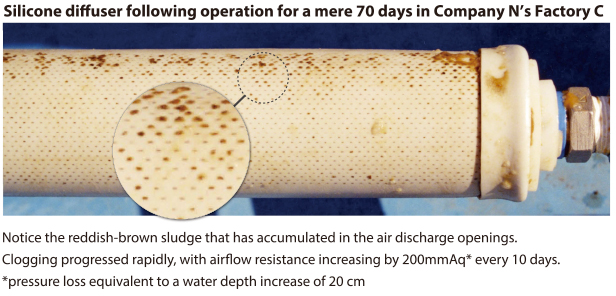
Is there space for the activated sludge to dry and accumulate inside the air diffuser?
By inspecting air diffusers from this point of view, it is easy to determine whether or not it will clog
Because rubber porous air diffusers have many fine air discharge openings, hot air from the air blower dries counterflowed sludge inside the air diffuser. This dried sludge is unable to leave through the fine openings and remains in the diffuser. Porous air diffusers therefore inevitably clog, and must be continually cleaned. Eventually, they have to be replaced within a few years.
On the other hand, the OHR AERATOR has a single large air discharge opening, which allows counterflowed sludge to exit the unit smoothly.
In other words, having one air discharge opening entirely prevents clogging. Any air diffuser with more than one inevitably clogs.
Moreover, there is no space whatsoever inside the OHR AERATOR for sludge to dry and accumulate.
This is why the OHR AERATOR never clogs.
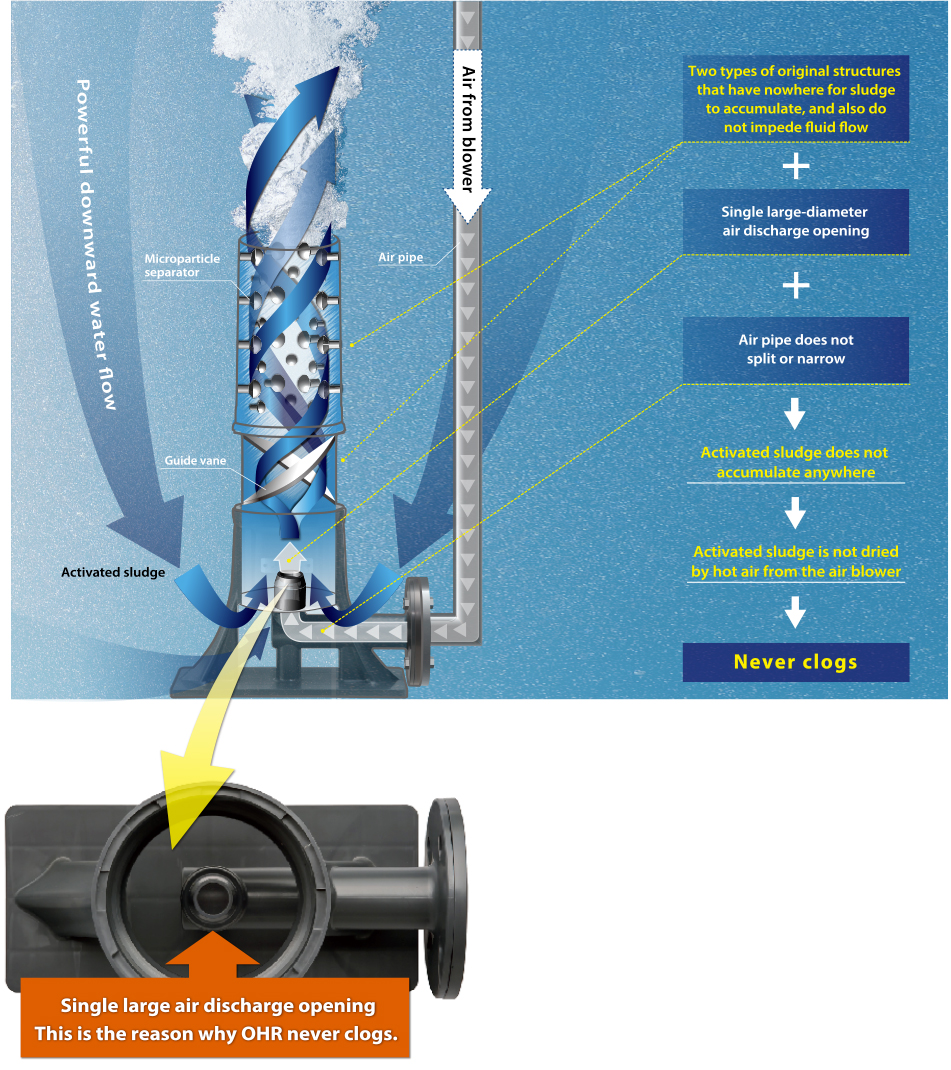
Comparison of OHR with porous air diffusers
 |
 |
| Technological concept | |
|---|---|
| Air and water are thoroughly mixed by hydrodynamic process to forcibly oxygenate the activated sludge. | In order to oxygenate activated sludge, air is discharged from many fine pores to increase the contact area. |
| Mechanism | |
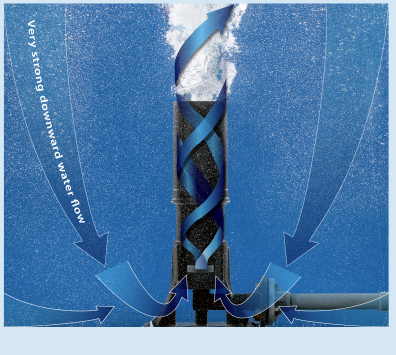 After air is blown from a large diameter hole of 30 mm, air and activated sludge are mixed powerfully by crossing plates and mushroom-shaped separators. |
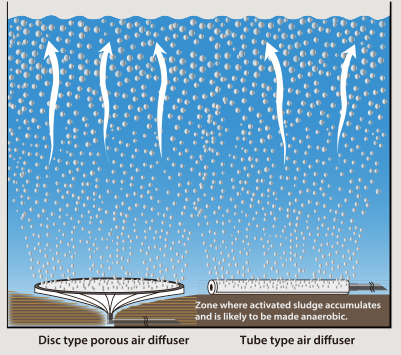 Air is blown from many fine pores that are a few hundred microns in size. No function for mixing air and wastewater provided, and whether or not oxygen is dissolved into wastewater is left to nature. |
| Fine bubbles | |
Generates many fine bubbles |
Less than 1/3 of the fine bubbles that OHR generates Conventional air diffusers have many air discharge openings, each a few hundred microns across. However, because of the water pressure, air bubbles discharge at a much larger size. Porous air diffusers therefore cannot generate large numbers of fine bubbles (on the order of 100μm). |
| Alpha value | |
| Approximately 1.0 The OHR AERATOR has the same OTR both in clean water and in wastewater. Although other air diffusers advertise high OTR values, these are measured in clean water. The OTR decreases drastically when used in actual wastewater. What is the ‘alpha value’? |
Approximately 0.2–0.7 Research institutions around the world have found that the OTR of conventional porous air diffusers falls drastically by up to 1/5, even in sewage water (which is low-load). In industrial wastewater, which is high-load, the fall in OTR is even more drastic and incurs large energy costs. |
| Clogging | |
| Never clogs Why the OHR AERATOR never clogs is plain and clear: because it has a single, large air discharge opening so activated sludge cannot dry or accumulate anywhere inside. |
Always clogs. So the OTR will inevitably decrease in time The claim made by manufacturers of rubber porous air diffusers that the check valve prevents activated sludge counterflow is not physically possible. When discharging air into wastewater using any air diffuser, activated sludge unavoidably counterflows in. Hot air from the air blower dries this sludge, which then accumulates inside the diffuser. |
| Units required | |
| Small number of units covers a large area (around 1/10 the number of porous air diffusers) The standard air blowing capacity of the OHR AERATOR model AE-130N is 1.0 m3/min. This is equivalent to 10 conventional porous air diffusers, which reduces the required number of units and therefore also significantly lowers the cost of installation. With just a handful of units, powerful flows churn the entire tank and prevent sludge from accumulating on the tank floor. Specifications |
Large number of units only covers a small area Because of the low air blowing capacity, a large number of units are required for installation. Discharged bubbles rise too slowly (about 30 cm/sec) to churn up the whole tank, causing sludge to accumulate. This creates an anaerobic zone that consumes oxygen that was to be used for wastewater treatment. |
| Performance in harsh conditions | |
| No recorded clogging even with intermittent aeration at an MLSS of 50,000–60,000 mg/L The OHR AERATOR never clogs, even in extreme conditions such as a high concentration of MLSS, or extremely infrequent intermittent operation (e.g. once a week). Real-world examples |
With a high concentration of MLSS, clogging gets progressively worse and the alpha value falls markedly In high-MLSS conditions, conventional air diffusers have another fatal flaw on top of rapid clogging. Because they entirely lack the ability to mix air and wastewater, the OTR will decrease drastically. |
| Installation | |
| No draining or anchoring to the tank floor required The body of the OHR AERATOR presses down on the floor of the tank because of the reaction force generated by the powerful upward air flow. This anchors the OHR AERATOR, so it can be installed without draining the tank in the majority of cases. |
Requires draining and anchoring Porous air diffusers store air before discharging. It is therefore necessary to anchor the diffuser to the tank floor to prevent it from floating off the bottom. Thus, installation and replacement require the tank to be drained, and the removal of both toxic gas and accumulated sludge. This is expensive and dangerous work. |




